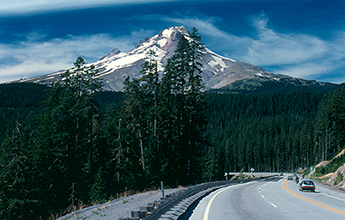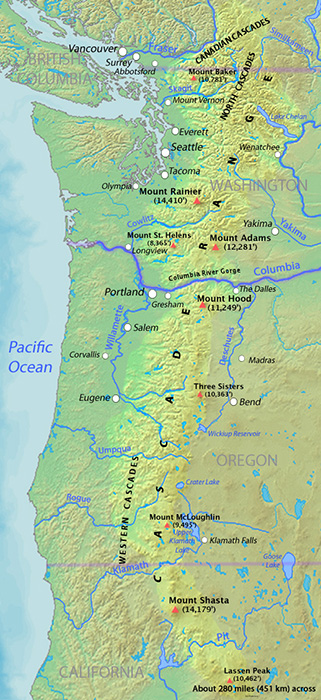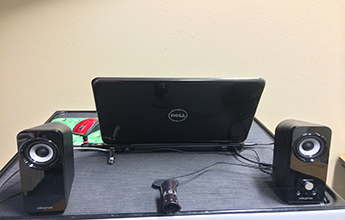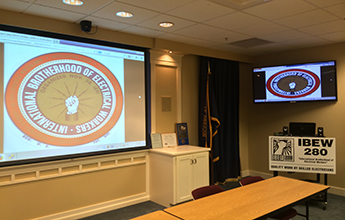
A Local’s Volcanic Problem,
|
 |
| Views like this make traversing the Cascades a beautiful, but long and potentially dangerous drive, preventing many members in central Oregon from attending local meetings in the Willamette Valley. |
For more than 100 members of Salem, Ore., Local 280 there was a problem in the way: a wall of volcanoes, extinct and active, 2 miles high and 80 miles wide called the Cascades. Local 280’s hall is in Tangent, on the lush west side of the Cascades in the Willamette Valley, but more than 120 members live on the other side.
“I can’t remember the last time a member from central Oregon who wasn’t working over here attended a meeting,” said Local 280 Business Manager Tim Frew. “I believe folks began to feel they were being treated like second-class members. I don’t want that division in the local.”
Members had been talking about how technology might offer a way to make that divide disappear, but a solution was not found until the summer of 2013 when the local put together a selection of off-the-shelf computer equipment and free and low cost software to create a flexible, mobile teleconferencing system.
“I just assumed in the 21st century, we should be able to do this,” Frew said.
Ain’t No Mountain High Enough
About 90 percent of Local 280’s more than 1,000 members make their home in Willamette Valley’s mixture of college towns, vineyards, light industry and rain. Their view of the west front of the Cascades is jagged collage of deep valleys darkened by giant stands of Douglas fir and serrated peaks muffled by hundreds of inches of snow each year.
 |
| The Cascade Range runs nearly 700 miles from British Columbia to Northern California and splits Local 280’s jurisdiction in two. Photo used under a Creative Commons license, courtesy Wikimedia-user Shannon |
The rest of the members live in the arid, rain shadow east of the range in the high desert of central Oregon, a vast plain nearly 4,000 feet above sea level. There are no sand dunes –an Oregon desert is a relative thing-- but the snowed in heights are ringed by the burnt yellows and browns of sage scrubland. Central Oregon towns are smaller. There are ranches instead of farms and, most importantly, it takes about two and a half hours to get to the local from Bend, the biggest town east of the Cascades.
“I love the drive. It has lots of switchbacks and you arrive when you get into the ponderosa pines. It is just a beautiful drive,” said Frew. “But you don’t want to do it after a meeting at the end of a long day. You wouldn’t get back in the Valley until near midnight and you never know what the weather is going to be.”
For many years, Local 280 had few members and low market share in the region and its slow economy offered few opportunities to bring it up. But recently, the economy has been picking up in the high desert. Particularly promising have been the spate of data centers. Local 280 already worked on a Facebook and Apple data centers in Prineville and there are rumors that many more are on the way, drawn by the renewable energy possibilities offered by the desert’s clear skies and cool nights.
“Central Oregon is a diamond in the rough,” Frew said. “There could be real opportunities there but only if we have a strong presence so that our contractors can be successful bidding the work.”
In late summer 2013, Frew decided to end years of discussions about how to better integrate the unit in Bend. He put the local’s central Oregon business representative, Nate Albertson, in charge of finding technology that would make the mountains disappear. In a few months, the local would be meeting to ratify the new contract for inside members and Frew wanted the decision made in one simultaneous meeting with all voices heard.
They began by surveying the local staff to find out how a video conferencing system might be used. After receiving feedback from the local staff, the training center and members from central Oregon, they began surveying other locals and unions with video conferencing systems about the equipment and software they used. The choices varied from little more than laptops with built-in webcams to elaborate systems with specialized cameras, hard-wired speakers and dedicated high-bandwidth connections to multiple locations.
“There was some really nice stuff out there, but often it was out of the scope of what we needed and too expensive,” Albertson said.
For example, the pipefitters’ hall, where Local 280’s central Oregon unit holds its monthly meetings, has multiple flat screens and in-wall speakers that could connect simultaneously to the six other pipefitter’s locals in the state.
 |
| Local 280 members can fully participate in meetings and trainings wherever there is a Wi-Fi signal using the laptop, freely available software and this HD video camera, speakers and an omnidirectional microphone |
“We realized for us flexibility and mobility were more important. We wanted to do meetings, but also more continuing education classes from the JATC to the east side,” Albertson said.
After much discussion, Training Director Dave Baker and Albertson built two mobile media carts with high-definition web cameras, high-quality microphones and cables, speakers run through a simple laptop. After looking at the many alternatives, they decided to use the free software application Skype --which allows two-way video calls over the Internet -- and the online fee-based service GoToMeeting service which allows video conferences with many different users in multiple locations.
“It wasn’t the most expensive webcam or microphone -- it was up there though—but as a whole, this is the simplest, most efficient and cost-efficient way to get this done,” Albertson said. “I can load it in my car, get it out and set it up myself. As long as we have an Internet connection, we can go anywhere, and with our iPads, we create a wireless hot spot anywhere we can get cell reception.”
Everything was in place for the October meetings. The Bend unit held its meeting, presided over by their chair, secretary and vice-chair, at the same time as the joint unit meeting at the training center in Tangent. Frew says he was pleased to see that the 21st century was indeed delivering on some of its promise.
“I was able to see the members in Central Oregon; they saw me and could talk to us. Everyone could ask questions and there were no glitches,” Frew said.
After the conversation, members at both meetings voted by secret ballot having heard from everyone who wanted to speak.
 |
| Salem, Ore., Local 280 used high quality, commercially available computers and peripherals to ensure members on both sides of the Cascade Range could fully participate in local meetings |
Since that first meeting, the system has been used for continuing education classes for east-side members. The communications cart was rolled the half-mile to the training center and set up in a lab. A teaching assistant in Redmond made sure the system was working and gave out the handouts.
Albertson and Frew said that there are limits on how much technology can actually do. For example, both support International Office policy that prohibits members from signing in and watching local meetings from home.
“You can overuse technology. We want to make it convenient, and have people be part of the meetings, but we want to see them there,” Albertson said. “You might have more participation but it wouldn’t necessarily be better participation. If you lose that human connection, what do you have?”
Frew said the key is balance.
“Nothing beats being with the members, looking them in the eye and talking about what’s going on,” he said. “When technology can help we should use it, but there is no brotherhood in a text message.”
Related News
Oregon Local Saves Prevailing Wage in Eugene
![]()